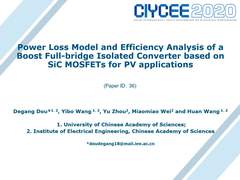
Start Time:2020-11-02 09:00 (Asia/Shanghai)
Duration:15min
Session:[B] Power Electronics Technology and Application » [B2] Session 13 and Session 18
Tips: The file permissions under this presentation are only for participants. You have not logged in yet and cannot view it temporarily.
Comment submit